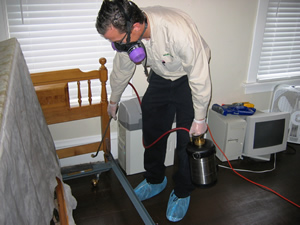Exploring the Scientific Research Behind Bed Bug Warm Treatments as a Sustainable Parasite Administration Technique
One such technique that has actually gained grip in current years is the usage of warm therapies to combat bed pest invasions. The ins and outs of just how heat effectively gets rid of bed bugs and the wider implications for sustainable parasite administration techniques make this a topic worth checking out further.
Bed Bug Warm Therapy Refine

Thermal Fatality Point for Bed Pests
Revealing bed insects to elevated temperatures beyond their thermal tolerance array is essential for accomplishing reliable eradication in warm treatment processes. By getting to and maintaining temperature levels above the thermal fatality point for bed insects, parasite administration professionals can make certain comprehensive removal of bed pest populations, including hard-to-reach areas where chemical therapies might be much less effective. Recognizing the thermal fatality point for bed pests is essential for applying effective heat treatment techniques and accomplishing sustainable parasite management end results.
Advantages of Heat Treatments
Having actually established the crucial thermal death point for bed pests, it is important to now explore the considerable benefits that warmth treatments provide in efficiently removing these durable insects. When contrasted to standard chemical methods, warmth treatments present several vital advantages. One of the main advantages is that warmth can permeate deep right into fractures and holes where bed pests hide, making sure that even one of the most hard-to-reach locations are warmed to deadly temperatures. This thorough method not just eliminates online pests yet also targets bed pest eggs, avoiding future infestations.
Moreover, heat treatments are safe and eco-friendly, making them a lasting pest management technique. Unlike chemical pesticides, warmth therapies do not leave hazardous residues that can pose threats to human health or the setting. This element is particularly crucial in delicate atmospheres such as medical facilities, colleges, and suburbs where chemical use might not be desirable.
Additionally, warmth treatments have a high success rate in eliminating bed insect problems in a solitary treatment, lowering the need for multiple gos to and minimizing disruption to owners. This efficiency not only saves money and time but also gives satisfaction to those taking care of bed bug issues.
Performance of Warm Therapy

Study researches have regularly shown the efficiency of warm therapies in accomplishing a high price of bed insect death. Appropriately performed warm therapies can reach all the gaps and splits where bed pests may be nurturing, making certain a detailed technique to elimination. Furthermore, heat treatments have the added advantage of killing bed pest eggs, which are often immune to typical chemical treatments. In general, the effectiveness of heat therapies in eliminating bed insect invasions makes them a dependable and sustainable pest management technique.
Sustainable Parasite Monitoring Benefits
Executing lasting insect monitoring techniques offers long-lasting advantages for both the setting and public health. By using techniques such as warmth therapies for parasite control, we can decrease the dependence on damaging chemical pesticides that can have damaging results on ecosystems and human health and wellness - bed bug heat treatment. Sustainable bug administration strategies assist in preserving biodiversity by targeting certain bugs without hurting non-target microorganisms, consequently preserving a balanced environment
In addition, lasting insect management techniques add to the total wellness and well-being of the general public. By reducing direct exposure to harmful chemicals utilized in conventional insect control techniques, warm treatments supply a more secure option for insect administration in property, commercial, and public rooms. This decrease in chemical usage also aids in stopping pesticide residues from contaminating water, air, and soil, protecting environmental top quality.
Verdict
To conclude, bed bug exterminator heat therapies have been shown to be a reliable and sustainable insect monitoring strategy. The thermal fatality point for bed insects makes them vulnerable to heat therapies, which have numerous advantages over standard chemical therapies. The performance of warmth treatments in eliminating bed bug problems while minimizing ecological impact highlights the capacity of this technique as a lasting option for pest control.
The bed pest heat therapy process involves raising the temperature level within infested areas to a degree that properly gets rid of bed insects and their eggs. By getting to and preserving temperatures above the thermal death point for bed bugs, bug administration experts can guarantee comprehensive removal of bed bug populations, consisting of hard-to-reach locations where chemical therapies may be less effective. One of the primary advantages is that heat can pass through deep into splits and gaps where bed pests conceal, making sure that also the most hard-to-reach areas are heated up to deadly temperatures. Unlike chemical treatments that may leave behind immune populations, warm treatments use a safe and environmentally pleasant service that can penetrate deep right into furnishings, walls, and various other hard-to-reach locations where bed insects hide.
The thermal death point for bed insects makes them vulnerable to warm therapies, which have various benefits over typical chemical treatments.